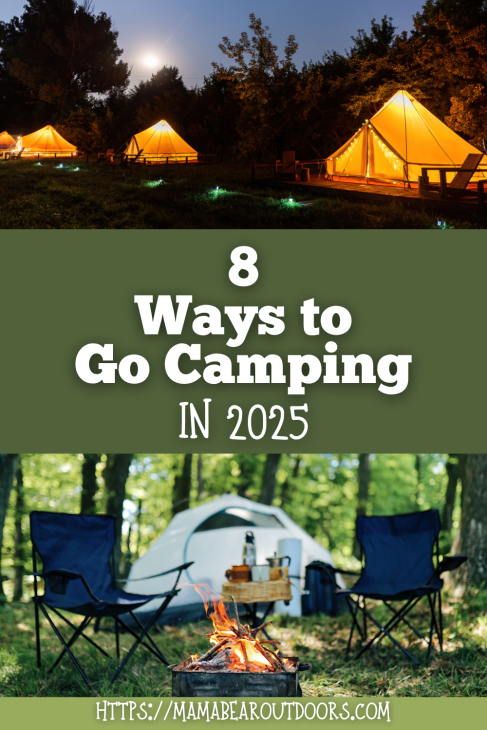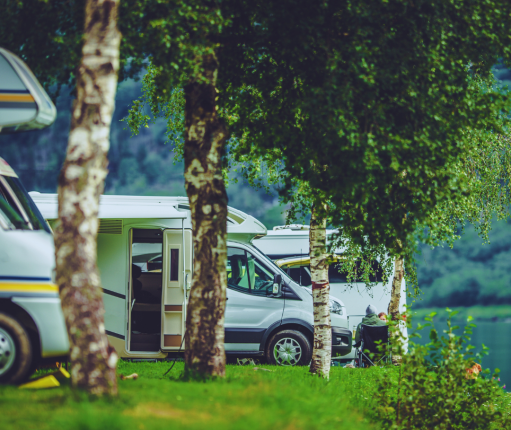Camping is one of the best ways to enjoy the great outdoors, unwind from daily stress, and reconnect with nature, but did you know there’s more than one way to camp? Whether you’re a seasoned outdoor enthusiast or a beginner looking for your first adventure, exploring the different types of camping can help you find the perfect fit for your comfort level, travel style, and budget. From traditional tent camping to luxurious glamping experiences, the options are as varied as the landscapes you’ll explore.
This guide will break down the most popular camping methods: RV camping, van and truck camping, tent camping, stealth camping, boondocking, dispersed camping, glamping, and hammock camping. You’ll learn what each camping style involves, the pros and cons, and tips for getting started. No matter how you like to adventure—off-grid, under the stars, or with modern comforts—you’ll discover a camping style that suits your needs and inspires your next outdoor getaway.
Best Ways To Camp in This Century
Because there are so many ways people can go camping, I’ve compiled a quick list of the different types of camping, what they are, and their pros and cons. Because we are all different, some types of camping may not suit you, but there may be one that does. I love car camping and stealth camping. My husband prefers RV camping, and my sister loves van or cowboy camping. So, whether you are off with your backpack or driving in your van to your favorite camping spot, here are all the ways to go camping.
1. RV Camping
RV camping is a popular way to explore the outdoors with many of the comforts of home still within reach. Whether you’re traveling in a motorhome, travel trailer, or camper van, RVs provide a mobile living space complete with beds, bathrooms, kitchens, and climate control. RV camping is especially appealing for families, long-term travelers, and those who want to enjoy nature without sacrificing convenience. Many RVers stay at designated campgrounds with full hookups for electricity, water, and sewage, while others seek out more remote locations for a boondocking adventure.
One of the biggest advantages of RV camping is the comfort it provides. With your own kitchen, bathroom, and climate-controlled living space, you can enjoy camping in nearly any weather. RVs also offer protection from rain, wind, and bugs, making them ideal for year-round travel. The generous storage space allows you to bring along everything from outdoor gear to extra clothes, and you never have to worry about setting up a tent or sleeping on the ground.
However, RV camping comes with some downsides. The initial investment in an RV can be significant, and ongoing maintenance, insurance, and fuel costs add up quickly. RVs also require specific parking areas and hookups, which can limit where you camp and add to your expenses. While you’re technically in nature, the experience can feel more like traveling in a mobile hotel room than immersing yourself in the wild. For those seeking a deeper connection with the outdoors, RV camping may feel a bit too insulated.
2. Van and Truck Camping
Van and truck camping offers a flexible and adventurous way to experience the outdoors, combining mobility with more comfort than traditional tent camping. Campers convert vans, trucks with toppers, or even SUVs into cozy, mobile shelters equipped with essentials like sleeping platforms, storage, and sometimes mini kitchens or power setups. This camping style is ideal for road trippers, weekend explorers, and anyone who enjoys off-the-beaten-path travel without the bulk of an RV.
One of the biggest advantages of van and truck camping is the freedom it offers. You can easily move from one destination to another, set up camp in scenic or remote areas, and adapt your vehicle to suit your personal needs and comfort level. It’s also more weather-resistant and secure than a tent, making it a great choice for those looking for a balance between comfort and rugged adventure. Plus, you can customize your setup—from minimalist sleeping arrangements to fully built-out camper conversions.
That said, van and truck camping isn’t without its challenges. Space is limited, which means packing light and staying organized are essential. You’ll also need to keep up with regular vehicle maintenance and consider fuel costs, especially if you’re traveling long distances. Parking can be tricky in urban areas or popular destinations, as not all locations allow overnight stays. Still, for those willing to navigate the trade-offs, van and truck camping offers an unmatched sense of freedom and exploration.
3. Tent Camping
Tent camping is the classic and most traditional way to enjoy the great outdoors. It typically involves setting up a portable shelter at a campground, in the backcountry, or even in your own backyard. This style of camping is a favorite for nature lovers, backpackers, and families alike because it offers a direct and immersive connection with the environment. Whether you’re camping in the mountains, forests, or by the beach, tent camping lets you truly unplug and experience the sights, sounds, and smells of nature.
One of the major benefits of tent camping is its affordability and accessibility. Tents are generally inexpensive, lightweight, and easy to transport, making this style of camping ideal for beginners or those on a budget. It allows for flexibility in location, and there’s a satisfying simplicity in setting up your own shelter and sleeping under the stars. For many campers, tent camping is the purest form of outdoor adventure—just you, your camping gear, and the natural world around you.
However, tent camping does come with a few drawbacks. Exposure to the elements means you’re more vulnerable to rain, wind, and temperature swings. Sleeping arrangements can be less comfortable compared to RVs or vehicles, and you’ll likely be limited in terms of storage and amenities. Additionally, tents offer minimal privacy and security, especially in busy campgrounds. Still, for those seeking a raw and rewarding outdoor experience, tent camping remains a timeless favorite.
4. Stealth Camping
Stealth camping involves sleeping overnight in a vehicle or tent in locations not designated as official campgrounds—often in urban or suburban areas—while remaining discreet and avoiding detection. It’s commonly practiced by van lifers, bikepackers, and minimalist travelers who value freedom, spontaneity, and a low-cost lifestyle. The key to stealth camping is blending in: parking in places that don’t draw attention and setting up camp without leaving a trace.
The appeal of stealth camping lies in its simplicity and flexibility. It’s a free way to camp, allowing you to stay close to city centers, trailheads, or attractions without paying campground fees or needing reservations. This minimalist approach encourages travelers to rely on only the essentials and think creatively about where to rest for the night. It also helps avoid overcrowded camping areas, offering a more peaceful and independent experience when done carefully.
However, stealth camping comes with notable downsides. Because it often takes place in unofficial areas, it may be illegal or against local ordinances, and campers risk being fined or asked to move. Safety can be a concern, especially in unfamiliar neighborhoods or isolated spots, and you won’t have access to basic facilities like restrooms or water. Successful stealth camping requires thoughtful planning, awareness of local rules, and a respectful, low-impact mindset to avoid issues.
5. Boondocking
Boondocking, also known as dry camping or wild camping, is a style of camping where you stay off-grid without access to traditional campground amenities like electricity, water, or sewer hookups. It typically takes place on public lands such as Bureau of Land Management (BLM) areas, national forests, or other undeveloped spaces. Boondockers rely entirely on their own resources, making it a favorite option for RVers, van lifers, and overlanders seeking solitude and freedom in nature.
One of the biggest advantages of boondocking is the cost—it’s completely free in most cases. You also get to enjoy secluded, quiet surroundings far from the crowds of established campgrounds. Boondocking allows campers to choose their ideal location, whether that’s a desert plateau with sweeping views, a shaded forest road, or a hidden lakeside spot. For those looking to truly unplug and escape the bustle, boondocking offers a peaceful, self-directed way to camp.
That said, boondocking requires careful planning and a high level of self-sufficiency. Without hookups, you’ll need to bring your own water, manage power through solar or generators, and handle waste responsibly. Roads to these remote spots can be rough, and isolation means limited access to help or supplies in case of emergencies. Boondocking is best suited for experienced campers or those ready to embrace the challenges of off-grid living in exchange for ultimate freedom.
6. Dispersed Camping
Dispersed camping refers to camping outside of designated campgrounds, typically on public lands like national forests and Bureau of Land Management (BLM) areas. Unlike boondocking, which is usually done with vehicles, dispersed camping often involves pitching a tent in remote, undeveloped areas. It’s a go-to choice for backpackers, minimalist campers, and adventurers seeking a quiet, off-the-grid experience surrounded by nature.
The benefits of dispersed camping are many—it’s free, remote, and far less crowded than traditional campgrounds. You’ll enjoy greater privacy, stunning natural settings, and the freedom to choose a campsite that suits your sense of adventure. Without designated sites or neighboring campers, it’s easier to feel immersed in the wild. For outdoor enthusiasts who value solitude and spontaneity, dispersed camping offers an unmatched opportunity to explore untouched landscapes.
However, dispersed camping also presents some challenges. No established amenities like bathrooms, water, or trash disposal exist, so campers must be prepared to follow Leave No Trace principles and be fully self-reliant. Access can be tricky, requiring navigation skills and a vehicle capable of handling rough or unmarked roads. It’s also important to research local regulations and land use rules to ensure you’re camping legally and responsibly in these unmanaged areas.
7. Glamping
Glamping—short for “glamorous camping”—combines the beauty of the outdoors with the comfort and luxury of a hotel stay. Instead of sleeping in a traditional tent or camper, glampers enjoy unique accommodations like safari tents, yurts, treehouses, cabins, or even domes. These setups often come with real beds, electricity, private bathrooms, and curated decor. Glamping is perfect for those who want to experience nature without sacrificing modern comforts.
One of the biggest draws of glamping is the ease and comfort it provides. Many glamping sites are fully equipped with linens, furniture, and even on-site services like meals, guided tours, or hot tubs. It’s a great option for people new to camping, couples seeking a romantic getaway, or families who want a stress-free outdoor experience. Glamping offers a memorable and Instagram-worthy stay with a touch of adventure and a lot of relaxation.
However, glamping isn’t for everyone. It often comes with a high price tag and may only be available in select locations or during certain seasons. Because everything is set up for you, it can feel more like a resort than a true outdoor adventure. For those craving an authentic, rugged camping experience, glamping might feel too polished or removed from nature. Still, it’s an excellent way to ease into the camping lifestyle with style and comfort.
8. Hammock Camping
Hammock camping offers a lightweight, minimalist alternative to traditional tent camping. Instead of sleeping on the ground, you suspend a hammock between two sturdy trees or posts, often with a rainfly and bug net for added protection. Popular among backpackers, thru-hikers, and minimalist campers, hammock camping provides a unique way to experience the outdoors—literally hanging out in nature.
One of the biggest advantages of hammock camping is its portability. Hammocks are lightweight, easy to pack, and quick to set up, making them ideal for hiking or traveling light. Many campers also find hammocks more comfortable than sleeping on hard or uneven ground. Plus, the elevated view and gentle rocking can offer a peaceful and immersive connection with the surrounding environment, making for a memorable and restful experience.
However, hammock camping does come with a few limitations. It requires suitable trees or structures spaced at the right distance, which isn’t always possible in certain terrains like deserts, alpine zones, or open plains. Weather protection can be minimal unless you carry additional gear like tarps and underquilts, and it may not be ideal for extreme temperatures or heavy storms. While it’s a fun and freeing way to camp, hammock camping works best in the right conditions and with some practice.
Final Thoughts on the Different Ways to Camp
No matter your style or experience level, there’s a perfect camping option out there for everyone. From the comfort of RV camping to the simplicity of tent camping, the off-grid freedom of boondocking to the luxury of glamping, each method offers a unique way to connect with the outdoors. By understanding the pros and cons of each camping style—whether it’s van life, stealth camping, dispersed camping, or hammock camping—you can choose the best fit for your next outdoor adventure.
Exploring the different ways to camp can help you make the most of your time in nature, whether you’re planning a weekend getaway or a cross-country road trip. With so many camping options available, there’s never been a better time to hit the road, pitch a tent, or hang a hammock and enjoy the great outdoors your way. So pack your camping gear, pick your destination, and discover which camping style brings out your inner explorer.

















No Comments